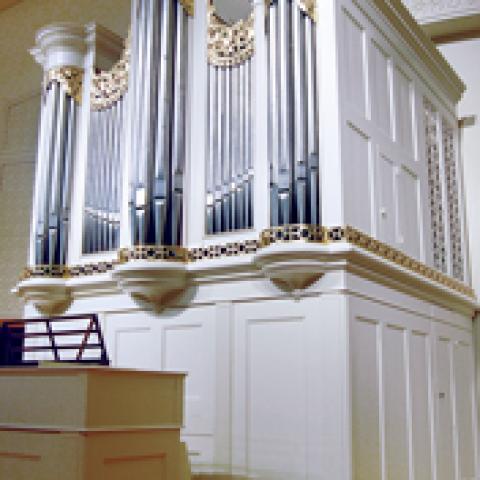WHAT
A major event for the national and international music community – the restoration, installation and rededication of an historic Tannenberg organ that lay disassembled and silent for almost 100 years and now is considered one of the most significant 18th century organs in the world and the largest 18th century American organ.
Old Salem invites the media to visit Old Salem while the organ is being reassembled and installed for one-on-one interviews with Old Salem historians and skilled craftsmen from Taylor & Boody Organbuilders in Staunton, VA, who are doing the restoration and installation, and to cover events during the March 19-21 festivities. Subject to availability, you may stay at one of our guest houses or make reservations at a bed-and- breakfast on site.
Network television, Minnesota Public Radio, Public Television and newspapers and music publications in the US and abroad already have begun preparation for coverage.
WHEN
Restoration is complete. Installation of the priceless Tannenberg organ is well under way in a concert hall at Old Salem designed especially for it.
Friday – Sunday, March 19-21
Three days of festivities celebrating the installation of the Tannenberg organ, including a dedicatory concert that will be recorded in cooperation with the Minnesota Public Radio program, Pipedreams, and released on a compact disc.
WHERE
Old Salem, the restored 18th Century Moravian community in Winston-Salem, NC, is one of the nation’s premier heritage tourism locations.
WHY
The disassembled organ created by revered organ builder, David Tannenberg of Lititz, Pennsylvania, presented the opportunity to share music produced on one of the finest 18th century organs in the world with music lovers and organ enthusiasts. It also makes available to organists a rare instrument of unsurpassed quality for concerts and recordings.
For more information, please contact
Carroll Leggett at Ralph Simpson & Associates
336.761.0711
[email protected]
__________________________________________________________
MORE BACKGROUND
Old Salem’s historic 18th Century Tannenberg organ
Beginning Friday, March 19, 2004, at Old Salem in Winston-Salem, NC, there will be three days of events to celebrate the restoration of the large, historic pipe organ built by David Tannenberg of Lititz, Pennsylvania, in 1799-1800 for the Moravian Church, Salem, North Carolina.
The widely anticipated highlight of the weekend will be hearing the instrument for the first time in 93 years. The dedicatory recital will be played on Friday evening, March 19, by the renowned organist, Peter Sykes, of Boston, Massachusetts. His program will feature music of the period as well as a newly commissioned piece by celebrated composer, Dan Locklair, a member of the faculty at Wake Forest University.
The rededication festivities will also feature a symposium on March 19-20, 2004, focused on the restoration of the organ and the music of its era. Speakers will include representatives from Taylor & Boody Organbuilders; Barbara Owen, organ historian and consultant; Laurence Libin, research curator, The Metropolitan Museum of Art; Raymond Brunner, author and organ builder; Dr. Nola Reed Knouse, director, Moravian Music Foundation; Dr. Daniel Crews, archivist, Moravian Archives; and Kristian Wegscheider, organ builder, Dresden, Germany. There is a charge to attend the seminar.
The weekend will conclude on Sunday afternoon, March 21 – David Tannenberg’s birthday – with a liturgical rededication of the organ.
This organ was first played in Salem’s new Moravian Church (now known as Home Moravian Church) in November 1800. Tannenberg, a Moravian himself, was one of the first organ builders in the American colonies, and this organ is his largest extant instrument. It is in its original, elaborately crafted cabinet made of native yellow pine and painted white. Old Salem has a smaller Tannenberg organ in its Single Brothers House and is the only site with two of Tannenberg’s masterpiece organs.
The organ was removed from Home Moravian Church and placed in storage in 1910. In 1998, Old Salem hired Taylor & Boody Organbuilders to reassemble the organ in a dramatic exhibit at Old Salem. When the exhibit closed, the organ was moved to the Taylor & Boody shop in Staunton, Virginia, where it has been undergoing careful and meticulous restoration.
The organ is on permanent loan from Home Moravian Church, which stands only a few hundred yards away, and is being installed in a hall designed specifically for it in Old Salem’s Visitor Center designed by renowned architect, Robert Venturi.
A printed brochure on the activities and registration details is available, and information also is posted on the Old Salem Web site, www.oldsalem.org.



